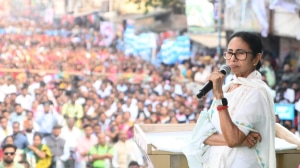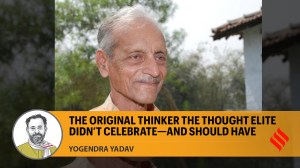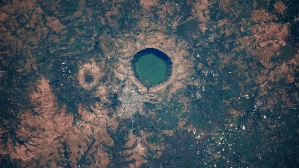After small Cabinet, heavyweight advisors for new Gujarat govt
Hasmukh Adhia and S S Rathore have specific areas of jurisdiction, with possibility of even broader mandates. Along with K Kailashnathan, could they be a one too many troika?
 Former Union finance secretary Hasmukh Adhia and retired bureaucrat of the Gujarat Engineering Services, S S Rathore. (Express photos)
Former Union finance secretary Hasmukh Adhia and retired bureaucrat of the Gujarat Engineering Services, S S Rathore. (Express photos) On December 12, when the new Gujarat government was sworn in under Bhupendra Patel, there were some sighs of relief at the Secretariat in Gandhinagar at the “continuity”, with no change of Chief Minister. There were also some concerns over Patel’s rather small Council of Ministers, sized 16, considering the massive mandate of 156 MLAs for the BJP in the recent election.
Almost two weeks later, the government announced former Union finance secretary Hasmukh Adhia, a retired Gujarat-cadre bureaucrat who headed the task force to achieve a USD 5 trillion economy target for India, as principal advisor to CM Patel. S S Rathore, a retired bureaucrat of the Gujarat Engineering Services, who helmed Sardar Sarovar Narmada Nigam Ltd and the Statue of Unity projects, and now heads the Metro Rail project in the state, was announced as the other advisor. Both are seen as close to Prime Minister Narendra Modi, having worked on some of his favourite initiatives when he was CM.
Besides, an extension was granted to K Kailashnathan as the Chief Principal Secretary to the CM, effective retrospectively from the day the new government took charge. While KK, as he is known, officially heads the Executive Council for the Sabarmati Ashram Redevelopment Project, it means a continuation at the top for the official considered the most powerful man in the state government given his proximity to PM Modi.
While the Gujarat government has previously too had advisors, sources say it is the first time that there is “such clear distribution of work” and broad mandate for them. In what gives an idea of the priorities of the new Bhupendra Patel government, Adhia has been tasked with monitoring economy, education, energy and investment-related policies, and Rathore with handling roads and buildings, civil aviation, metro rail, water resources, Narmada and Kalpasar. The government has kept the option open of adding “any other sectors” to their portfolios, thus making their roles all-encompassing.
The tenure of the two advisors is “co-terminus” with that of the chief minister or “until further orders”, while KK’s extension is for now of just a year.
An official said the selection of the advisors showed that the BJP realised the high expectations from its government. “It has to do a fine balancing act between high economic growth and social justice,” the official said, citing the compromise the previous government had to make regarding the stray cattle law. “If the government had to cancel the law to please one community that opposed it, it also must listen to those harassed by stray cattle on the streets, as they have also voted for it,” the official reasoned.
Patel is seen as best equipped to implement these divergent aims of the government, and has been given ample room with no deputy CM to cramp him, as had happened in the case of Rupani. Patel is also seen by bureaucrats favourably as a “solution-oriented” CM, being a businessman himself. (He owns a construction firm based in Ahmedabad). “Advisors are key to the current dispensation given that the government in power is relatively inexperienced, while the targets set for it are ambitious,” a former bureaucrat said.
Another former state official anticipated some issues going forward. “The appointments leave several grey areas in the way the Chief Minister’s Office (CMO) will work, as the pecking order is not clear. The Chief Secretary is the head of the administration, but given these powerful posts that have been created, which cover almost all the sectors of the government, what happens to his role remains to be seen.”
Before he headed the Gujarat economy task force, Adhia helmed an economic revival plan under CM Vijay Rupani, which submitted its report in June 2020, at the peak of the Covid-19 pandemic. The report envisaged a Gross State Domestic Product (GSDP) target of Rs 38.64 lakh crore for Gujarat, for it to “help India” achieve the target of USD 5 trillion economy by 2026-27, in time for the next Assembly elections. A former IAS officer with a doctorate in yoga, Adhia was posted in the CMO during Modi’s tenure in 2003-2005.
“The distribution of files which come to the CMO registry will decide who is how important, apart from the space they (the advisors) are allotted in the CMO,” said a bureaucrat, who worked in the Narendra Modi, Anandiben Patel as well as Rupani governments. The seating plans were being worked out soon after the announcement of the names of the advisors on Tuesday.
An official said: “There have been instances earlier when, at high-profile meetings with the PM, for instance, only two officers would be allowed. Usually that would be the Chief Secretary and the secretary in-charge of the sector concerned, leaving out the advisor. What happens now will be interesting.”
Apart from the weight of his long stint in Gujarat, Kailashnathan is the senior-most among the three by virtue of belonging to the 1979 batch. For long now, he has been a “key link” between the party and government apart from the Gujarat and Centre.
The BJP governments in Gujarat have had a long tradition of advisors. A retired bureaucrat who worked in the CMO recalled that 1961 batch’s S K Shelat, the Chief Secretary under CM Keshubhai Patel, was named economic advisor on retirement. When Modi took over, he continued with Shelat as advisor and, in 2008, appointed Kireet Joshi, a philosopher and former IAS officer of 1955 batch, as his education advisor.
In 2007, Modi hired water resources expert Babubhai Navalawala as yet another advisor, and he continued through the Rupani government. Rupani’s tenure saw retired Air Marshal R K Dhir join as advisor on defence and aerospace, in run-up to Gujarat hosting the Defence Expo.
An official pointed out that there was a crucial difference this time from the earlier advisors. They were hired for specific areas but the roles assigned to Adhia and Rathore are wider, the official said.



- 01
- 02
- 03
- 04
- 05




























